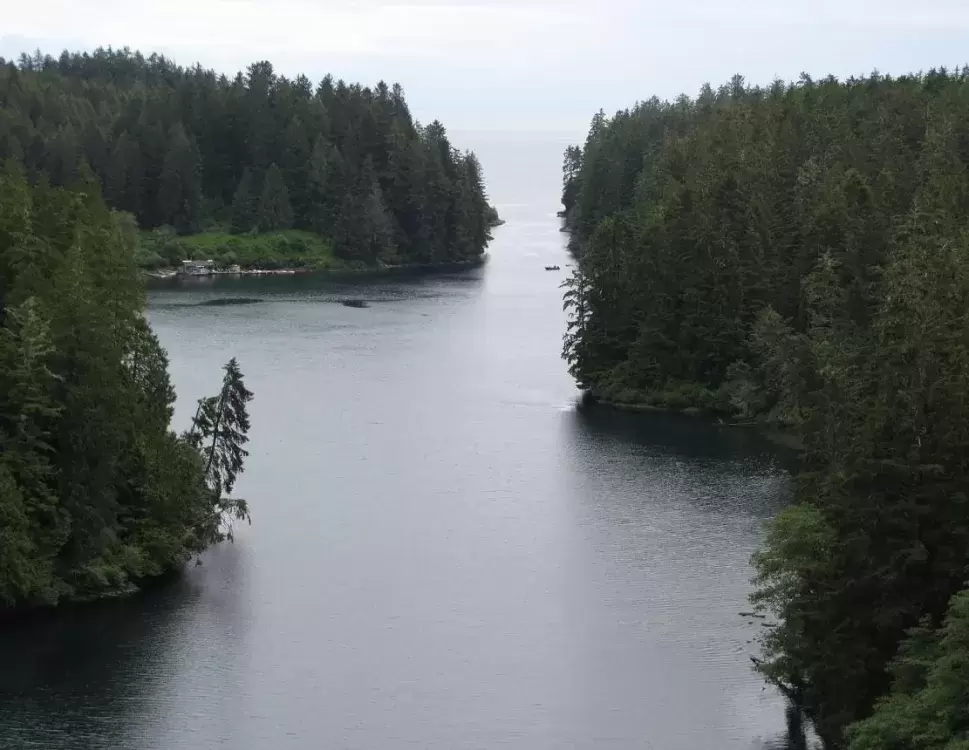Tourist traffic is ramping up on the West Coast Trail, and the creation of a third entrance to the historic hiking path has provided a welcome economic boost for Ditidaht First Nation.
Originally hacked out of the wilderness as a lifesaving trail between Port Renfrew and Bamfield in 1907, the West Coast Trail is part of Pacific Rim National Park, and operated by Parks Canada in partnership with Ditidaht, Pacheedaht and Huu-ay-aht First Nations. Since 2014, visitors have had the option of starting their journey at Nitinat Narrows.
For hikers with the mandatory Trail Use Permits, that means staying overnight at the Nitinat Lake Motel, having dinner at Carl’s Crab Shack (included), then getting up next morning for orientation at the Ditidaht First Nation Nitinat Lake Visitor Centre (which doubles as a General Store). Then it is time for the water taxi ride down the lake, followed by a ferry ride across the Narrows to the Trail entrance at Wya. The season runs from May 1 through Sept. 30.
“As of the 1st, we have been steady-busy,” Rachel Mathiassen told Ha-shilth-sa, noting that the hiking parties include school groups taking advantage of the new access to the Trail.
Visitor Centre Manager and Ditidaht member Ann Pettet explained that while hikers can spend up to 14 days hiking the entire Trail, the Nitinat Narrows entrance opens up a range of options, especially when combined with the Nitinat Triangle Canoe Route, which links Hobiton, Squalicum and Tsusiat Lakes.
“Our school groups typically start on the Nitinat Triangle. They portage their canoes into Hobiton Lake, then hike into the West Coast Trail. Another school group starts at Pachena Bay. They meet up, swap backpacks and canoes, and come out the other end. So they do a portion of canoeing and backpacking.”
The Nitinat Triangle is also part of Pacific Rim National Park, and specific fees and permits are required depending on the planned itinerary, Pettet explained. The Trail requires overnight passes, while the Triangle requires day passes.
“We are limited to 25 (overnight passes) per day, either standby or advance. We do have a bit of flexibility, because it is our territory,” she said. “We already expect 1,000 for the season, pre-booked.” That is [for visitors] just coming through us.”
Visitors who chose the Nitinat Narrows entrance can hike north 32 kilometres to Pachena Bay or take the longer (43 kilometres) southern stretch to Port Renfrew.
Since becoming a new Trail terminal, the economic activity has ramped up to match the increased visitor traffic, Pettet said. The General Store/Visitor Centre is part of the Ditidaht Development Corporation (DDC), which negotiated the contract with Parks Canada for the third entrance.
“We also have something called Comfort Camping. It’s on one of the old family reserves on Tsuquada Point,” she said.
“It’s canvas tents with cots. It provides a little bit of shelter. It’s for people who don’t want to do the entire Trail, but want to have a taste of what it’s like on what I call ‘the Edge of the World’,” Pettet said.
Because of the rough water at Tsuquada Point, campers must hike 2.5 kilometres from the Trail entrance to the Comfort Camping site. But from that point, they are free to explore as desired.
The Comfort Camping permit fee is a fraction of the full Trail fee.
All told, the growing tourism picture is part of an overall strategy as Ditidaht moves forward in treaty negotiations, according to DDC director Jack Thompson Sr.
“It’s all part of our economic development strategy, and hopefully, it will become a big thing,” Thompson said. “We are currently in the treaty process in partnership with our neighbour, Pacheedaht.”
While the main focus is on obtaining Aboriginal title to lands and resources, Thompson said Pacific Rim National Park forms part of the bigger treaty picture.
“We are dealing with Parks Canada, but the details remain confidential while negotiations are in progress,” he said.
DDC executive director Bryan Cofsky said Ditidaht began negotiating with Parks Canada nearly 20 years ago, and the process has evolved considerably.
“There was an issue with the West Coast Trail being an ungazetted trail. Parks [Canada] was using it without any First Nations consultation at all,” Cofsky said. “So rather than litigation, we began conversation, which always works better in the end.”
That led to the creation of the Ditidaht Parks Cooperative Management Board, which is made up of three Ditidaht members and three (or four) Parks Canada representatives.
“The third entrance negotiations started five or six years ago. The early negotiations were mainly for compensation for the use of the right-of-way,” he explained. “Once we got that under our belt, we started looking for [mutual] economic opportunities.”
Pettet noted a Ditidaht/Pacheedaht treaty settlement could alter some of the terms of use for visitors on the Trail.
“We provide the same orientation that visitors receive at [Port Renfrew and Pachena Bay],” she said. “When we do the orientation we mention each territory, whether it is Pacheedaht, Ditidaht or Huu-ay-aht.
“We do make a note that, because Huu-ay-aht is part of the Maa-Nulth Treaty, there are the Treaty Settlement lands. This is acknowledged on the signage. And there are [areas] that are out of bounds,” Pettet said. “We do talk about that. And we will soon be ‘Treaty Settlement’ as well,” she added.








